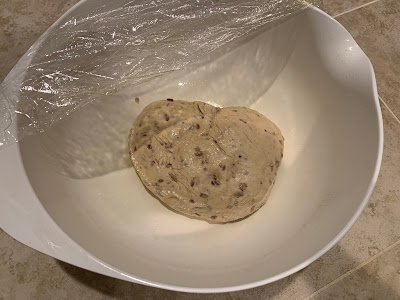The ingredients that ended up going into the bread were:
- 1 red onion ($0.77)
- a few tsp of dried sage ($0.10)
- freshly ground black pepper ($0.02)
- olive oil (not measured, used in several instances) ($0.40)
- 2-1/4 tsp yeast (equivalent of one packet) ($0.40)
- 1/2 tbsp sugar ($0.06)
- 3/4 cup warm water ($0)
- 2-1/2 cups all purpose flour, plus more for kneading (another cup or so) ($0.40)
- 1 tsp salt ($0.02)
- olive oil cooking spray ($0.15)
- Herbes de Provence ($0.20)
- a few grinds of salt ($0.02)
You might notice that there are two onions in that ingredient photo while the ingredient list only mentions one. When I started, I was following the measurements in the original recipe, but it just seemed like such a big recipe, using two packets of yeast and five cups of flour, so I decided after already chopping the onions to cut the recipe in half. The total cost for the bread was a little more than $2.50, which is pretty good considering how much bread it made. We ate it with plant-based breakfast sausage and some vegetables (zucchini, carrots, and the other chopped red onion), each of which cost approximately $4, so it was about $10.50 for a lot of food.
I generally followed along with the steps in the recipe, also using some techniques and tips we picked up from some of our bread-baking classes this fall. The steps for making our version of the bread were:
1. Prep - finely chop red onions.
2. In a skillet over medium heat, add some olive oil, and once hot, add onions, dried sage, and some black pepper. Cook until onions are soft and then set aside to cool.
3. In a small bowl, add the yeast, sugar, and warm water. Stir and then let sit for about 10-15 minutes. (It should be frothy and growing.) After that, add about 1/2 tbsp of olive oil.
4. In a large mixing bowl, combine the flour and salt. Then add the yeast mixture and onions, and mix well, making adjustments of water/flour until texture is ready for kneading. (I added a little water.)
5. Put dough on a flour-dusted surface and knead for at least 5 minutes, adding flour or water as needed. (I kneaded it for 15, adding a little bit of flour each time as I kept going along, totaling probably around one cup. I don't know how to explain how I decided when to stop, but it was based on the stickiness and stretchiness of the dough. I also used the windowpane test.)
6. Spray the inside of a big bowl with olive oil cooking spray, put dough in the bowl, flip over, and spray the top with more cooking spray. Cover with plastic wrap (also sprayed with cooking spray on the inside). Set aside to proof for 45-50 minutes until it doubles in size. (I used the microwave as bread proofer here, and after trying that a month or so ago, we haven't done it any other way.)
7. Once dough has doubled in size, punch it down gently, divide it into 2 pieces, and shape into loaves. (Even though I was only making half of the recipe, I still separated it in two.)
8. Grease a rimmed baking sheet, add loaves, and brush loaves with enough olive oil to cover them.
9. In a small bowl, combine a few grinds of freshly ground black pepper, a few grinds of salt, and a few spoonfuls of Herbes de Provence, and mix well. Sprinkle over loaves, and then let loaves sit uncovered for another 30 minutes to rise.
10. Preheat oven to 350 degrees. Bake loaves for about 30 minutes. (We checked the temperature to see if it was 190 degrees at that point, and it was more. The original recipe said to leave it until the crust was golden brown. Ours didn't get that golden, but we pulled it out anyway.)
11. Remove loaves and cool on wire rack.
I loved the texture of this bread. It came out so soft, which was good for me, because I like soft bread more than bread with a harder crust. Each slice was soft, pillowy, and so full of olive oil and herbs in flavor. It was like biting into bread that had been dipped in olive oil and herbs, but without the actual dipping. I was having memories of Carrabba's (haven't been there in years since they closed the one near my parents) and their delicious bread, olive oil and herb mix, and it reminded me so much of that. As far as the challenge, you could taste the sage as part of the herb mix, but I don't think I would say that the bread tasted strongly of just sage.
This bread was so delicious that A and I definitely ate more calories in bread than we were planning to, but it was so hard to stop eating, especially knowing that freshly baked bread tastes so much better right out of the oven than out of the fridge or freezer (although it was pretty good out of the fridge the next day too). I'm still amazed that I baked a real loaf of bread, something that I would have never expected to say if you asked me a year ago. (But who would have predicted 2020 last year?) I've come a long way since my first yeast experiment with the lolo buns (that turned into a cake) earlier this year, and I'm still shocked that this was made with my own two hands. I would definitely make this bread again.






No comments:
Post a Comment